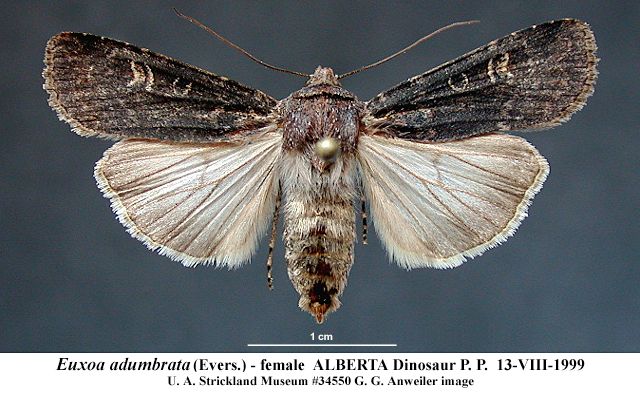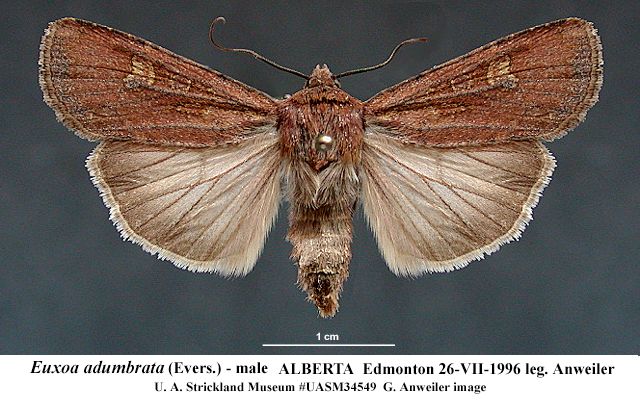Species Details
Euxoa adumbrata
University of Alberta E.H. Strickland Entomological Museum Read more about this collection »
SeasonalityAdults are on the wing in Alberta from early June through August, with the main flight July-August.
IdentificationAdults of adumbrata are medium-size (3.4-4.0 cm wingspan) rather narrow-winged noctuid moths. The sexes are dimorphic; females are dark blackish-brown and males red-brown. Females are essentially unmarked except for pale scales outlining the reniform and orbicular spots. Males are almost identical to red specimens of Euxoa ochrogaster, and to a lesser degree to Euxoa mimallonis. The male genital characters mentioned above will separate adumbrata from the others. Males of mimallonis also have shining white hindwings, not dirty white or sooty as in adumbrata. The male genital characters can be observed in most specimens without dissection.
The Sordid Dart belongs to the Euxoa subgenus Chorizagrotis, characterized by long, apically spatulate saccular extension and short harpes in the male. The only other member of the subgenus in Alberta is E. auxiliaris, which can be separated by its shorter harpes (3 times as long as wide in auxiliaries versus 5 times as long as wide in adumbrata). Females of Chorizagrotis may be separated from females of other Euxoa subgenera by their dorsoventrally flattened abdomen.
Keys to the adults of the genus, subgenera and species are provided in Lafontaine, 1987.
The nomenclature of adumbrata has gone through a number of changes in recent years; it has been treated as both drewseni (Staud.) and lidia (Stoll) (Hardwick, 1970; Lafontaine, 1987).
Scientific Name
Euxoa adumbrata
Habitat
Grasslands, meadows, cultivated areas and other open areas.
Seasonality
Adults are on the wing in Alberta from early June through August, with the main flight July-August.
Identification
Adults of adumbrata are medium-size (3.4-4.0 cm wingspan) rather narrow-winged noctuid moths. The sexes are dimorphic; females are dark blackish-brown and males red-brown. Females are essentially unmarked except for…
Adults of adumbrata are medium-size (3.4-4.0 cm wingspan) rather narrow-winged noctuid moths. The sexes are dimorphic; females are dark blackish-brown and males red-brown. Females are essentially unmarked except for pale scales outlining the reniform and orbicular spots. Males are almost identical to red specimens of Euxoa ochrogaster, and to a lesser degree to Euxoa mimallonis. The male genital characters mentioned above will separate adumbrata from the others. Males of mimallonis also have shining white hindwings, not dirty white or sooty as in adumbrata. The male genital characters can be observed in most specimens without dissection.
The Sordid Dart belongs to the Euxoa subgenus Chorizagrotis, characterized by long, apically spatulate saccular extension and short harpes in the male. The only other member of the subgenus in Alberta is E. auxiliaris, which can be separated by its shorter harpes (3 times as long as wide in auxiliaries versus 5 times as long as wide in adumbrata). Females of Chorizagrotis may be separated from females of other Euxoa subgenera by their dorsoventrally flattened abdomen.
Keys to the adults of the genus, subgenera and species are provided in Lafontaine, 1987.
The nomenclature of adumbrata has gone through a number of changes in recent years; it has been treated as both drewseni (Staud.) and lidia (Stoll) (Hardwick, 1970; Lafontaine, 1987).
Life History
Adults are nocturnal and come to light. There is a single brood annually.
Larvae have been reared in the lab, but nothing of the habits or host plants is known.
Conservation
A common, widespread species; no concerns.
Diet Info
No data. Related Euxoa species feed on a variety of herbaceous plants.
Range
Holarctic. In North America adumbrata occurs across northern Canada from Quebec to western Alaska, south to the northern tier of states, and in the mountains to Colorado. In Alberta it has been collected throughout…
Holarctic. In North America adumbrata occurs across northern Canada from Quebec to western Alaska, south to the northern tier of states, and in the mountains to Colorado. In Alberta it has been collected throughout the southern half of the province.
References
Author
Lafontaine, J. Donald
Title
Noctuoidea : Noctuidae (part)
Publication Date
1987
Pages
237
Author
Hardwick, D.
Title
The Genus Euxoa (Lepidoptera: Noctuidae) in North America. Subgenera Orosagrotis, Longivesica, Chorizagrotis, Pleonectopoda, and Crassivessica.
Publication Date
1970
Series Title
Memoirs of the Entomological Society of Canada
Volume
37
Specimen Information
There are 86 specimens of this Species.
UASM114783 - Euxoa adumbrata
University of Alberta E.H. Strickland Entomological Museum
Place CollectedCanada: Alberta, Kananaskis Country, Hailstone Butte
Collected ByTroubridge, J.
Date Collected1993-07-19
UASM114784 - Euxoa adumbrata
University of Alberta E.H. Strickland Entomological Museum
Place CollectedCanada: Alberta, Kananaskis Country, Hailstone Butte
Collected ByTroubridge, J.
Date Collected1995-07-13
UASM114785 - Euxoa adumbrata
University of Alberta E.H. Strickland Entomological Museum
Place CollectedCanada: Alberta, Kananaskis Country, Hailstone Butte
Collected ByTroubridge, J.
Date Collected1995-07-15
UASM114786 - Euxoa adumbrata
University of Alberta E.H. Strickland Entomological Museum
Place CollectedCanada: Alberta, Kananaskis Country, Hailstone Butte
Collected ByTroubridge, J.
Date Collected1995-07-13
UASM114787 - Euxoa adumbrata
University of Alberta E.H. Strickland Entomological Museum
Place CollectedCanada: Alberta, Kananaskis Country, Hailstone Butte
Collected ByTroubridge, J.
Date Collected1995-07-13
UASM114788 - Euxoa adumbrata
University of Alberta E.H. Strickland Entomological Museum
Place CollectedCanada: Alberta, Kananaskis Country, Hailstone Butte
Collected ByTroubridge, J.
Date Collected1995-07-13
UASM114789 - Euxoa adumbrata
University of Alberta E.H. Strickland Entomological Museum
Place CollectedCanada: Alberta, Kananaskis Country, Hailstone Butte
Collected ByTroubridge, J.
Date Collected1995-07-13
UASM114790 - Euxoa adumbrata
University of Alberta E.H. Strickland Entomological Museum
Place CollectedCanada: Alberta, Kananaskis Country, Hailstone Butte
Collected ByTroubridge, J.
Date Collected1998-07-25
UASM114791 - Euxoa adumbrata
University of Alberta E.H. Strickland Entomological Museum
Place CollectedCanada: Alberta, Kananaskis Country, Hailstone Butte
Collected ByTroubridge, J.
Date Collected1998-07-25
UASM114792 - Euxoa adumbrata
University of Alberta E.H. Strickland Entomological Museum
Place CollectedCanada: Alberta, Kananaskis Country, Hailstone Butte
Collected ByTroubridge, J.
Date Collected1995-07-13
UASM114793 - Euxoa adumbrata
University of Alberta E.H. Strickland Entomological Museum
Place CollectedCanada: Alberta, Kananaskis Country, Hailstone Butte
Collected ByTroubridge, J.
Date Collected1995-07-13
UASM114794 - Euxoa adumbrata
University of Alberta E.H. Strickland Entomological Museum
Place CollectedCanada: Alberta, Kananaskis Country, Hailstone Butte
Collected ByTroubridge, J.
Date Collected1995-07-13
UASM114795 - Euxoa adumbrata
University of Alberta E.H. Strickland Entomological Museum
Place CollectedCanada: British Columbia, Blowdown Pass
Collected ByTroubridge, J.
Date Collected1992-08-01
UASM114796 - Euxoa adumbrata
University of Alberta E.H. Strickland Entomological Museum
Place CollectedCanada: Alberta, Mount Hamell
Collected ByTroubridge, J.
Date Collected1994-07-27
UASM114797 - Euxoa adumbrata
University of Alberta E.H. Strickland Entomological Museum
Place CollectedCanada: Saskatchewan, Burstall
Collected ByTroubridge, J.
Date Collected1998-07-01
UASM114798 - Euxoa adumbrata
University of Alberta E.H. Strickland Entomological Museum
Place CollectedCanada: British Columbia, Mount Kobau
Collected ByTroubridge, J.
Date Collected1998-07-17
UASM114799 - Euxoa adumbrata
University of Alberta E.H. Strickland Entomological Museum
Place CollectedCanada: Alberta, Opal
Collected ByTroubridge, J.
Date Collected1999-07-12
UASM114800 - Euxoa adumbrata
University of Alberta E.H. Strickland Entomological Museum
Place CollectedCanada: British Columbia, Watch Peak
Collected ByTroubridge, J.
Date Collected1998-07-24
UASM114801 - Euxoa adumbrata
University of Alberta E.H. Strickland Entomological Museum
Place CollectedCanada: British Columbia, Watch Peak
Collected ByTroubridge, J.
Date Collected1998-07-24
UASM114802 - Euxoa adumbrata
University of Alberta E.H. Strickland Entomological Museum
Place CollectedCanada: British Columbia, Watch Peak
Collected ByTroubridge, J.
Date Collected1996-08-16/1996-08-17
UASM114803 - Euxoa adumbrata
University of Alberta E.H. Strickland Entomological Museum
Place CollectedCanada: British Columbia, Watch Peak
Collected ByTroubridge, J.
Date Collected1998-07-24



